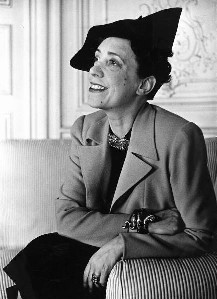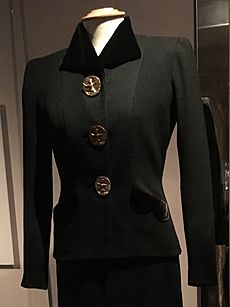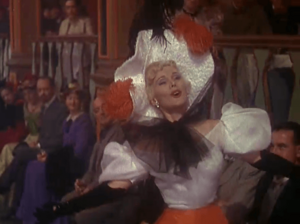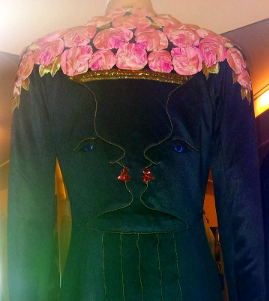Elsa Schiaparelli facts for kids
Quick facts for kids
Elsa Schiaparelli
|
|
|---|---|

Schiaparelli in 1937, wearing her own designs
|
|
| Born |
Elsa Luisa Maria Schiaparelli
10 September 1890 Rome, Italy
|
| Died | 13 November 1973 (aged 83) Paris, France
|
| Occupation | Fashion designer |
| Spouse(s) |
Wilhelm Frederick Wendt de Kerlor
(m. 1914; div. 1924) |
| Children | 1 |
| Relatives | Marisa Berenson (granddaughter) Berry Berenson (granddaughter) |
Elsa Schiaparelli (born September 10, 1890 – died November 13, 1973) was a famous fashion designer from an important Italian family.
She started her own fashion house, Schiaparelli, in Paris in 1927. She led this company from the 1930s to the 1950s. Schiaparelli began with knitwear, and her designs were known for being artistic and unique, often inspired by Surrealism. Her collections featured unusual themes like the human body, insects, or trompe-l'œil (which means "trick the eye"). She also loved using bright colors, especially her famous "shocking pink."
Elsa Schiaparelli worked with famous artists like Salvador Dalí and Jean Cocteau.
Many people consider her one of the most important fashion figures in Europe between World War I and World War II. She was a big rival of another famous designer, Coco Chanel. Some of her clients included the wealthy Daisy Fellowes and the actress Mae West.
Contents
Early Life and Family
Elsa Luisa Maria Schiaparelli was born in Rome, Italy, in a grand building called the Palazzo Corsini. Her mother, Giuseppa Maria de Dominicis, came from a noble family. Her father, Celestino Schiaparelli, was a very smart scholar who studied many things, including the Islamic world and the Middle Ages. He was also an expert in Sanskrit and managed old books. He even served as the Dean of the Sapienza University of Rome, where Elsa later studied philosophy.
Elsa's uncle, Giovanni Schiaparelli, was an astronomer who discovered features on Mars that he called canali (channels). Young Elsa often looked at the stars with him. Another cousin, Ernesto Schiaparelli, was a famous Egyptologist who found the tomb of Nefertari.
Her family's rich cultural background helped spark Elsa's imagination when she was a child. She loved learning about ancient cultures and old traditions. These stories inspired her to write a book of poems called Arethusa, based on an ancient Greek myth. Her parents were worried by her wild imagination and sent her to a strict boarding school in Switzerland. But Elsa didn't like the rules and went on a hunger strike, so her parents had to bring her home.
Elsa felt that her comfortable life was too quiet and boring. She wanted adventure and to see more of the world. When a friend offered her a job taking care of orphaned children in an English country house, she saw it as a chance to leave. However, she didn't like this job either. Instead of going back to Rome, she decided to return to Paris.
Marriage and Travels
Elsa went to London to avoid marrying a wealthy Russian man her parents liked, but whom she didn't want to marry. In London, Elsa, who had always been interested in psychic things, went to a lecture about theosophy (a spiritual philosophy). The speaker was Willem de Wendt. He was a very charming man who claimed to have psychic powers and many degrees, but he was actually a trickster.
Elsa was immediately drawn to him, and they got engaged the day after they met. They married on July 21, 1914. Elsa was 23, and Willem was 30. They lived mostly on money from Elsa's parents. Willem tried to make money by pretending to be a psychic. In 1915, they had to leave England because Willem was caught practicing fortune-telling, which was against the law. They then moved around a lot in France before going to America in 1916.
In New York, Willem tried to become famous with his "Bureau of Psychology." Elsa helped him by doing office work and writing things for newspapers to make him seem important. During this time, the government's Bureau of Investigation (which later became the FBI) watched Willem. They were suspicious of his work and his views during wartime. In 1918, they moved to Boston. Authorities questioned them, but decided they were more foolish than dangerous.
Their daughter, Maria Luisa Yvonne Radha, nicknamed 'Gogo', was born on June 15, 1920. Soon after, Willem left Elsa and Gogo. Elsa told Gogo that her father had died. In 1921, Gogo, at 18 months old, was diagnosed with polio, which was very difficult for both of them. To protect Gogo, Elsa legally changed her daughter's last name to Schiaparelli before they returned to France in 1922.
Elsa found comfort and support from her friend Gabrielle 'Gaby' Buffet-Picabia, who was married to the artist Francis Picabia. Elsa had met Gaby on the ship to America. After Willem left, Elsa returned to New York, enjoying its lively culture. Her interest in spiritualism connected her to the Dada and Surrealism art movements. Through Gaby, she met artists like Man Ray and Marcel Duchamp. Elsa and Willem finally divorced in March 1924.
Return to Paris and Early Career
After her time in New York, Elsa Schiaparelli moved back to France in 1922. She rented a fancy apartment in Paris and hired staff. Because of her family's high social standing and the friends she had made, she was welcomed into important social groups in France.
Even though her mother still sent her money, Elsa wanted to earn her own income. She helped Man Ray with his art magazine, but it didn't last long. Her friend Gaby Picabia suggested they sell French fashion in America, but this idea didn't work out.
Fashion Career
Elsa Schiaparelli's early fashion career was influenced by the designer Paul Poiret. He was known for getting rid of tight corsets and long dresses, creating styles that allowed women to move freely. Schiaparelli later called Poiret "a generous mentor, dear friend."
Elsa didn't have formal training in making patterns or sewing clothes. She designed by instinct, often draping fabric directly onto a body, sometimes even her own. This was similar to Poiret's method. Her designs looked natural and comfortable to wear.
House of Schiaparelli
While in Paris, Elsa, known as "Schiap" to her friends, started making her own clothes. With encouragement from Poiret, she opened her first business, but it closed in 1926. She then launched a new collection of knitwear in early 1927. These sweaters featured surrealist trompe-l'œil images, like a scarf that looked like it was wrapped around the wearer's neck.
Her designs appeared in Vogue magazine. Her business really took off with her "pour le Sport" collection, which included bathing suits, ski-wear, and linen dresses. In 1931, Schiaparelli added evening wear, using luxurious silks. Her business grew stronger, and in 1935, she moved to a famous salon at 21 Place Vendôme, which she renamed the Schiap Shop. Her salon and studios were in a grand 17th-century building.
When France declared war on Germany in 1939, Schiaparelli's Spring 1940 collection included "trench" brown and camouflage-printed fabrics. After Paris fell to Germany in June 1940, Schiaparelli went to New York for a lecture tour. She stayed there until the war ended. When she returned, fashion had changed. Christian Dior's "New Look" was popular, which was very different from pre-war styles. The House of Schiaparelli struggled after the war. Elsa closed her couture business in 1951 and finally shut down her design house in December 1954. This was the same year her rival Coco Chanel returned to fashion.
Later Life and Legacy
In 1954, Schiaparelli wrote her autobiography called Shocking Life. She then lived a comfortable retirement, splitting her time between her Paris apartment and a house in Tunisia. She passed away on November 13, 1973, at the age of 83.
Even though her business closed, Elsa Schiaparelli was a very important designer. In 1934, Time magazine called her one of the top fashion houses, saying she was "Madder and more original than most of her contemporaries." They often used the word 'genius' to describe her. Time also noted that her designs were quickly copied, and millions of people wore her styles even if they didn't know her name.
Notable Designs
Elsa Schiaparelli was a pioneer in fashion. She was one of the first designers to create the wrap dress. She got the idea from aprons, making a design that would fit and look good on all women. Her wrap dress, first seen in 1930, had armholes on both sides and wrapped around the front, tying at the waist. It was popular for beachwear and was later copied for everyday clothes.
In 1931, Schiaparelli's divided skirt, which was like early shorts, surprised the tennis world when Lili de Alvarez wore it at Wimbledon.
Other new ideas included a swimsuit with a built-in bra and a low-cut back, using hidden straps. This design was patented in 1930. She also made clothes with parts that could be taken off or reversed. In 1930, she created the first evening dress with a matching jacket. During the time of Prohibition in the United States, her "speakeasy dress" even had a secret pocket for a small bottle of alcohol.
Fastenings

Schiaparelli was one of the first designers to show zippers on clothes in 1930. Instead of hiding them, she made zippers a key part of her designs, placing them visibly on necklines, sleeves, and skirts. She used thick plastic zippers made from new materials like cellulose nitrate. She worked with zipper makers to promote their products.
Schiaparelli was also famous for her unusual buttons. They looked like candlesticks, playing card symbols, ships, crowns, mirrors, or even crickets. Some were silver tambourines or silk-covered carrots and cauliflowers. Many of these unique fastenings were designed by Jean Clemént and Roger Jean-Pierre, who also made jewelry for her. In 1936, Schiaparelli was one of the first to see the talent of Jean Schlumberger, whom she first hired to design buttons.
Jewellery
Schiaparelli also created unique costume jewelry. One famous design was a 1938 necklace made of clear plastic (Rhodoid) with colorful metal insects by Clément. This made it look like bugs were crawling on the wearer's skin. In the 1930s, her jewelry was made by Schlumberger, Clemént, and Jean-Pierre. Schlumberger's jewelry, with its creative mix of precious and semi-precious stones, was very popular. Schiaparelli also featured brooches by Alberto Giacometti and fur-lined metal cuffs by Méret Oppenheim.
Textiles
Schiaparelli was known for using new and interesting fabrics. She used textiles woven to look like tree bark or crumpled paper. She also used a soft fabric that looked like ermine fur and prints with newspaper clippings. She made clothes from wrinkled rayon, long before other designers did. Schiaparelli loved to play with different colors, shapes, and textures. She embraced new technologies and materials. She experimented with acrylic, cellophane, and rayon with metal threads. Some of these new fabrics were tricky; for example, her 1934 "glass" cape made from a transparent plastic called Rhodophane was not continued.
Artist Collaborations
Elsa Schiaparelli's amazing imagination and her interest in the Dada and Surrealism art movements led her to new creative ideas. Her unique style made her stand out from her main rival, Coco Chanel, who called her "that Italian artist who makes clothes." Schiaparelli worked with many artists, most famously with Salvador Dalí, to create some of her most famous designs. She also worked well with artists like Leonor Fini and Alberto Giacometti.
In 1937, Schiaparelli worked with the artist Jean Cocteau on two notable designs for her Autumn collection. One evening jacket had an embroidered female figure with one hand around the wearer's waist and long blonde hair flowing down a sleeve. A long evening coat featured two faces looking at each other, creating the optical illusion of a vase of roses. Famous embroiderers, Lesage, did the detailed work on both garments.
Dalí Collaborations
The designs Schiaparelli made with Salvador Dalí are some of her most famous. Besides well-known pieces like the shoe hat and the Lobster, Tears, and Skeleton dresses, Dalí's influence can be seen in other designs too. While Schiaparelli didn't officially name her designs, four main pieces from her work with Dalí are widely known:
- Lobster Dress
The 1937 Lobster dress was a simple white silk evening dress with a red waistband. It featured a large lobster painted by Dalí onto the skirt. Dalí had started using lobsters in his art in 1934. The lobster design for Schiaparelli was printed onto fabric. This dress became famous when Wallis Simpson wore it in photographs taken by Cecil Beaton before her marriage to Edward VIII.
- Tears Dress
The Tears Dress was a slim, pale-blue evening gown printed with a Dalí design of trompe-l'œil (trick the eye) rips and tears. It was worn with a veil that had "real" tears carefully cut out and lined in pink and magenta. This dress was part of the February 1938 Circus Collection. The print was meant to look like torn animal skin, with the tears showing fur on the inside of the fabric.
- Skeleton Dress
Dalí also helped Schiaparelli design the Skeleton Dress for the Circus Collection. It was a plain black crepe dress that used a special quilting technique called trapunto quilting to create padded ribs, a spine, and leg bones.

- Shoe Hat
In 1933, Dalí was photographed by his wife Gala Dalí with one of her slippers on his head. In 1937, he drew designs for a shoe hat for Schiaparelli. She included it in her Fall-Winter 1937–38 collection. The hat was shaped like a woman's high-heeled shoe, with the heel pointing up and the toe tilted over the wearer's forehead. Gala Dalí, Schiaparelli herself, and the heiress Daisy Fellowes (a top client) all wore this hat.
Film Costumes
Schiaparelli designed costumes for several films. She started with the French version of Topaze in 1933. Her last film work was for Zsa Zsa Gabor's outfits in the 1952 movie Moulin Rouge, where Gabor played Jane Avril. The costumes for Gabor were based on portraits of Avril by the artist Henri de Toulouse-Lautrec.
She also famously dressed Mae West for the 1937 film Every Day's a Holiday. Schiaparelli used a mannequin shaped like Mae West, which later inspired the bottle for her "Shocking" perfume.
The House of Schiaparelli Today
The House of Schiaparelli first opened in the 1930s at 21 Place Vendôme. After World War II, Elsa Schiaparelli's collections didn't find the same success. The fashion house closed on December 13, 1954. In 1957, she created a company mainly for her perfume licenses, which is the company that exists today.
In 2007, Italian businessman Diego Della Valle bought the company. In September 2013, Marco Zanini was appointed, and plans for the brand's return became public. The house has since been invited back to the exclusive Chambre Syndicale de la Haute Couture list of members. They presented their first show in January 2014. Schiaparelli now sells its collections in a very exclusive way, by appointment only in Paris. The company is also moving towards luxury Ready-to-wear clothing.
Perfumes
Schiaparelli's perfumes were known for their unique bottles and packaging. Her most famous perfume was "Shocking!" (1936). Its bottle was sculpted by Leonor Fini in the shape of a woman's torso, inspired by Mae West's dressmaker's dummy and Dalí's paintings. The packaging was in "shocking pink," one of Schiaparelli's signature colors. This color was said to be inspired by a pink diamond owned by Daisy Fellowes.
Other perfumes included:
- Salut (1934)
- Souci (1934)
- Schiap (1934)
- Sleeping (1938)
- Snuff (for men; 1939)
- Roi Soleil (1946)
- Zut! (1948)
Family
Elsa Schiaparelli had two granddaughters from her daughter's marriage to Robert L. Berenson: model Marisa Berenson and photographer Berry Berenson. Both sisters often appeared in Vogue in the early 1970s. Berry was married to the actor Anthony Perkins, and they had two children, actor Oz Perkins and musician Elvis Perkins. In 2014, Marisa worked with Hubert de Givenchy to publish a book called Elsa Schiaparelli's Private Album, which showed photos from her grandmother's personal collection.
Exhibitions
- "Shocking!" The Art and Fashion of Elsa Schiaparelli, shown at the Philadelphia Museum of Art (2003–2004) and the Musée de la Mode, Paris (2004).
- Schiaparelli and Prada: Impossible Conversations; at The Costume Institute of The Metropolitan Museum of Art (2012).
- Designer Christian Lacroix created a fashion collection to honor Schiaparelli at the Musee des Arts Decoratifs in 2013.
See also
 In Spanish: Elsa Schiaparelli para niños
In Spanish: Elsa Schiaparelli para niños



